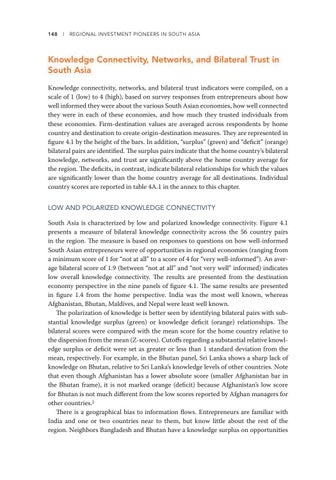148 l REGIONAL INVESTMENT PIONEERS IN SOUTH ASIA
Knowledge Connectivity, Networks, and Bilateral Trust in South Asia Knowledge connectivity, networks, and bilateral trust indicators were compiled, on a scale of 1 (low) to 4 (high), based on survey responses from entrepreneurs about how well informed they were about the various South Asian economies, how well connected they were in each of these economies, and how much they trusted individuals from these economies. Firm-destination values are averaged across respondents by home country and destination to create origin-destination measures. They are represented in figure 4.1 by the height of the bars. In addition, “surplus” (green) and “deficit” (orange) bilateral pairs are identified. The surplus pairs indicate that the home country’s bilateral knowledge, networks, and trust are significantly above the home country average for the region. The deficits, in contrast, indicate bilateral relationships for which the values are significantly lower than the home country average for all destinations. Individual country scores are reported in table 4A.1 in the annex to this chapter. LOW AND POLARIZED KNOWLEDGE CONNECTIVITY South Asia is characterized by low and polarized knowledge connectivity. Figure 4.1 presents a measure of bilateral knowledge connectivity across the 56 country pairs in the region. The measure is based on responses to questions on how well-informed South Asian entrepreneurs were of opportunities in regional economies (ranging from a minimum score of 1 for “not at all” to a score of 4 for “very well-informed”). An average bilateral score of 1.9 (between “not at all” and “not very well” informed) indicates low overall knowledge connectivity. The results are presented from the destination economy perspective in the nine panels of figure 4.1. The same results are presented in figure 1.4 from the home perspective. India was the most well known, whereas Afghanistan, Bhutan, Maldives, and Nepal were least well known. The polarization of knowledge is better seen by identifying bilateral pairs with substantial knowledge surplus (green) or knowledge deficit (orange) relationships. The bilateral scores were compared with the mean score for the home country relative to the dispersion from the mean (Z-scores). Cutoffs regarding a substantial relative knowledge surplus or deficit were set as greater or less than 1 standard deviation from the mean, respectively. For example, in the Bhutan panel, Sri Lanka shows a sharp lack of knowledge on Bhutan, relative to Sri Lanka’s knowledge levels of other countries. Note that even though Afghanistan has a lower absolute score (smaller Afghanistan bar in the Bhutan frame), it is not marked orange (deficit) because Afghanistan’s low score for Bhutan is not much different from the low scores reported by Afghan managers for other countries.5 There is a geographical bias to information flows. Entrepreneurs are familiar with India and one or two countries near to them, but know little about the rest of the region. Neighbors Bangladesh and Bhutan have a knowledge surplus on opportunities

